Autopilot: How to use Insights and set Journey goals
What is Insights?
Insights allows you to:
- measure the performance of a Journey against a goal;
- view the average number of days and touches it takes to convert someone; and
- compare how each message in a Journey is performing.
How do I set a goal?
You can set a goal from the canvas tab by clicking "Set a Goal". You can also set a goal from the Insights tab:

If contacts have previously entered the Journey, Insights will automatically analyze the last 90 days of data so you can see your performance prior to setting the goal. This make take up to a few minutes depending on the number of contacts that have previously entered the Journey.
What does each goal setting do?
Goal name
This allows you to give a "friendly" name to the group of contacts that complete the goal. Enter something clear so that anyone on your team can understand what the Journey is trying to achieve.
Conversion target
This is used to display a benchmark on the conversions chart, so you can see how you are tracking against your goal. There are two target types:
- "% of the contacts that enter this journey" (i.e. relative); or
- "contactsthatenterthisjourney" (i.e. fixed).
Select the former if you are trying to convert a percentage of contacts that enter the Journey over time. Select the latter if you are trying to convert a specific number of contacts, regardless of how many enter the Journey over time.
For ongoing Journeys, we recommend using a relative target.
List or smart segment that defines a conversion
This is used to calculate conversions (see below under "How do conversions work?"). Select a list or smart segment with criteria that represents a converted contact. For example, you might select:
- a paying customer list; or
- a smart segment with criteria "LeadStatus" is "ClosedWon".
Expected conversion window
This is used to limit the time range within which a conversion must occur to be counted. For example, if you only want to count those contacts who convert within 30 days of entering the Journey, select "30days".
Journey type
This will be used to let you know how you're tracking against industry standards.
How do conversions work?
To convert, a contact must complete the goal (i.e. be added to the list, or enter the smart segment):
- after they enter the Journey. In other words, if a contact is already on the list or smart segment when they enter the Journey, then they are not eligible to convert; and
- within the expected conversion window.
When it comes to ejection, a contact will not be counted as a conversion if they complete the goal after being ejected from a Journey. However, if they are ejected from a Journey and then re-enter it at a later date (without having completed the goal in the meantime), then they become eligible to convert again.
How do I edit or change a goal?
After you've set a goal you can edit any setting except for the list or smart segment that defines a conversion; this is to ensure consistency in the conversion metrics:

If you want to change the goal, you can remove it and set a new one:
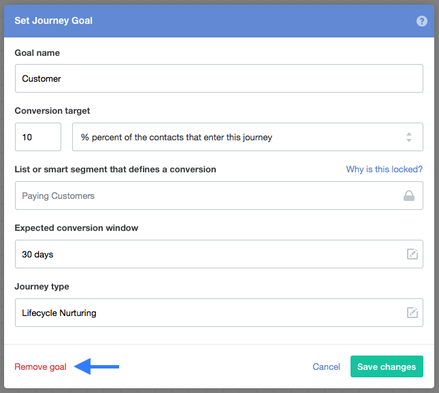
Please bear in mind that when you remove a goal, any conversion data older than 90 days will be permanently removed. As noted above, when you set a new goal, Insights will automatically analyze the last 90 days of data so you can see your performance prior to setting the goal.
How can I view different date ranges and intervals?
By default all metrics are displayed for the last 30 days, in daily increments. However, you can change this:
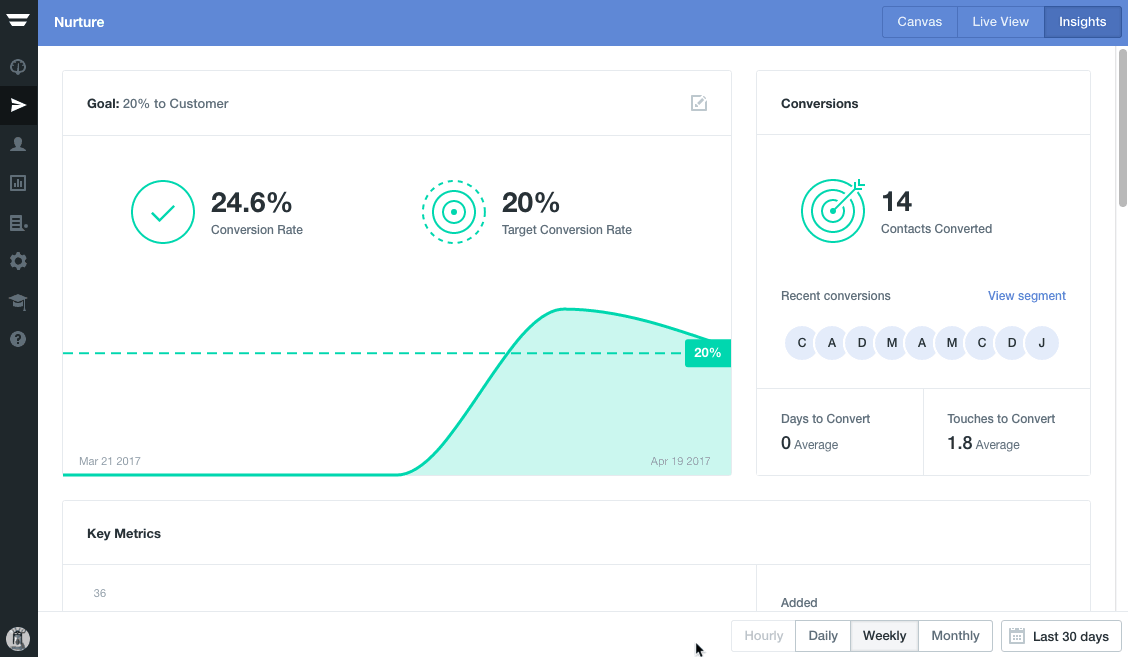
As demonstrated above, to use the hourly view, please select the "Last 7 days" view.
What do the metrics mean?
Conversions chart
For relative targets, this chart displays your current conversion rate, and how you are tracking against your target:
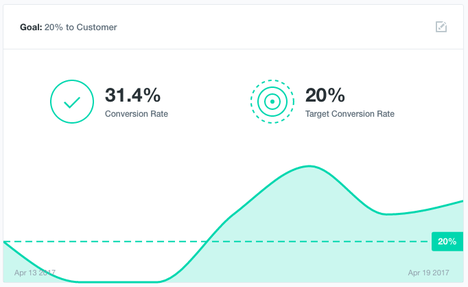
For fixed targets, this chart displays your all-time conversions, and how you are tracking against your target:
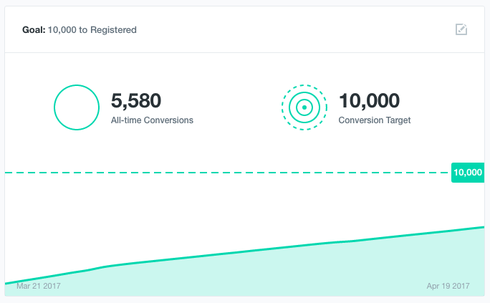
On the right hand side you'll see recent conversions, as well as two additional metrics:
- Days to convert: the average number of days a contact was in the Journey before converting.
- Touches to convert: the average number of messages contacts received before converting.
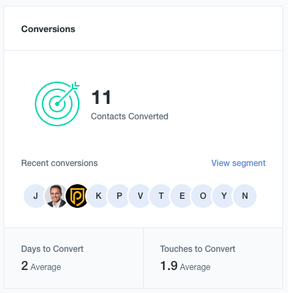
Note that if a contact is ejected from a Journey, then their contribution to these two metrics is reset.
Key metrics chart
This chart displays three metrics:
- Added: the number of unique contacts who entered the Journey.
- Converted: the number of unique contacts who converted (see above under "How do conversions work?").
- Ejected: the number of unique contacts who were ejected from the Journey.
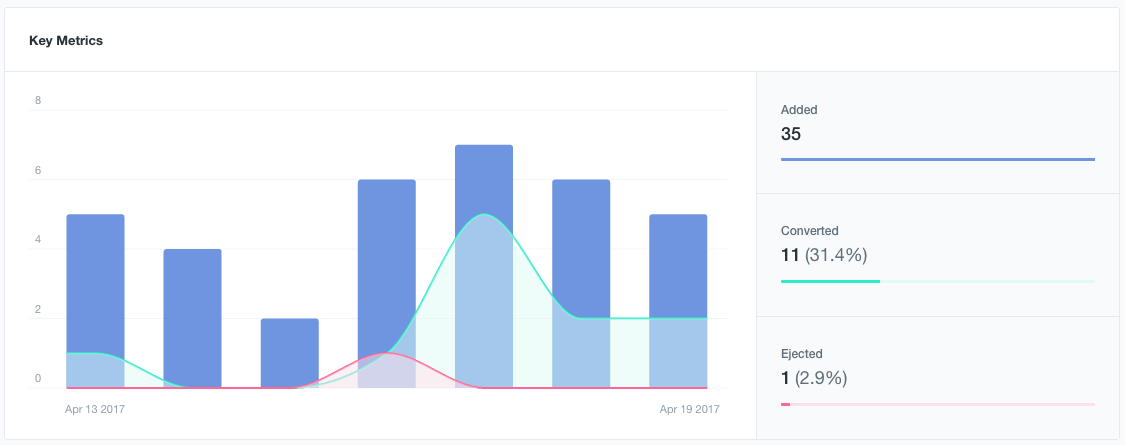
As noted above, all of these metrics are unique. This means, for example, that even if a contact is added to a Journey more than once, they will still only count once towards the "added" metric.
Email performance vs conversions chart
This chart displays five metrics:
- Delivered: the number of unique email deliveries (excludes bounces).
- Opened: the number of unique email opens.
- Clicked: the number of unique email clicks.
- Unsubscribed: the number of unique unsubscribes.
- Converted: the number of unique contacts who converted (see above under "How do conversions work?").

Please note that this chart is intended to give you a historical view of all emails ever sent in this Journey. This means that even if you remove an email, its metrics will still count towards the totals.
How does the Message Timeline work?
The Message Timeline provides an overview of the messages in a Journey. It is broken down by day based on delays in a Journey:
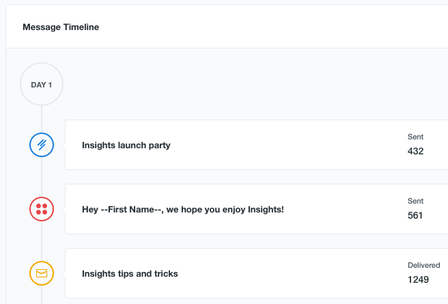
Please note that the Message Timeline is indicative only. It does not mean all contacts in a Journey will receive each message listed; it simply means that the message would be sent on the specified day if a contact flows into it.
How can I remove contacts that convert from a Journey?
In some cases (e.g. lead nurtures) you may wish to remove contacts that convert from a Journey. To do this, anywhere on your Journey connect the List Trigger or Smart Segment Trigger to the Eject from Journey action, selecting the same list or smart segment that you used to define your goal:
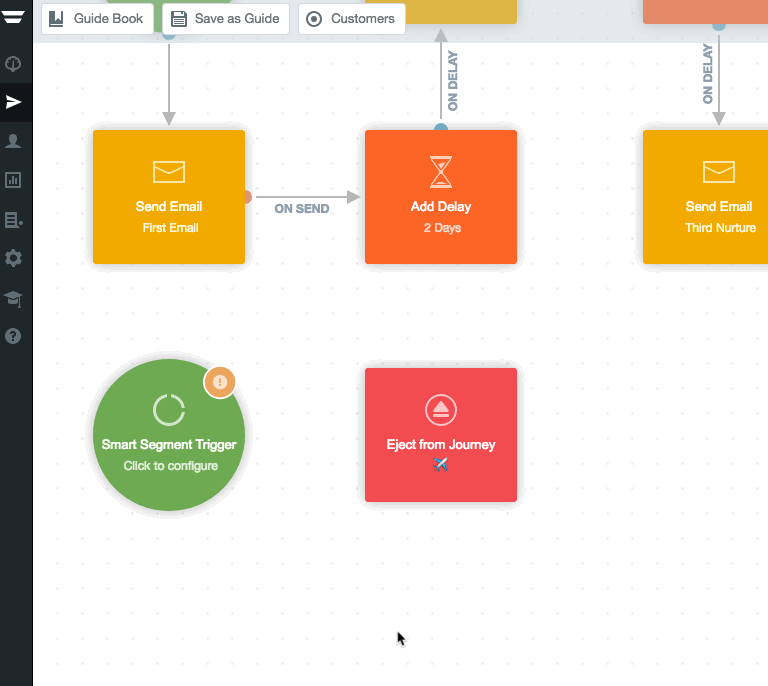
As demonstrated above, ensure that you choose the second option on the trigger, i.e. "Add contacts that enter this segment in the future".
Which time zone does Insights use?
Insights uses your computer's current time zone. This ensures data is always displayed in a way that is relative to you.
Can I use Insights on mobile and tablet devices?
Yes, just login from your mobile or tablet devices to access Insights. It has been designed to be fully responsive based on the device you're using. For example, below is Insights on the iPhone:
We recommend adding Autopilot to your home screen (learn how to do this on iOS or Android) so you can easily access it on the go:
